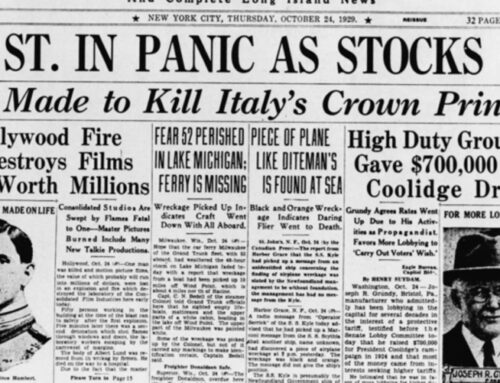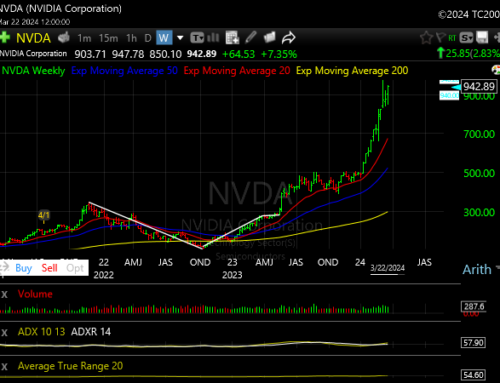 One lesson I’ve had to learn over the years is that it is very difficult to forecast major moves in the overall stock market.
One lesson I’ve had to learn over the years is that it is very difficult to forecast major moves in the overall stock market.
Over the extreme long run, the U.S. stock market has a tendency to rise. However, there are instances when it pays to stay on the sidelines, or to exit the market altogether.
The goal to understanding current circumstances is to produce higher risk adjusted returns over the long run.
There are basically four phases of the market…
1) The market is bullish and rising
2) The market is correcting within a bull market
3) The market is bearish and falling
4) The market is correcting within a bear market
Market participants are always at odds as to which is the current phase of the market
The Dow Theory is an approach to monitoring the stock market derived from the Wall Street Journal editorials written by Charles Dow.
Dow was a journalist and the first editor of the Wall Street Journal and co-founder of Dow Jones and Company. Dow himself never used the term “Dow Theory” nor presented it as a trading system
There are six basic tenets to Dow Theory
First, the market has three movements
- The primary trend may last from just under a year to several years or more and it can be bullish or bearish
- The medium swing or intermediate reaction may last from a couple weeks to several months or more
- The short swing may last from several days to a month
Secondly, major market trends have three phases
1) The accumulation phase where professional investors are actively buying or selling stock against the general opinion of the market. During this phase the price of the market does not change much because these investors are in the minority
2) In the second phase, the public catches on and a rapid price change occurs in the market. This phase will continue until rampant speculation occurs
3) The astute investors begin to distribute their positions to the market.
The Third tenet of Dow Theory is that the market DISCOUNTS all news.
Stock prices quickly incorporate new information as it becomes available. Once news is released the market changes in price to reflect the new information.
The Fourth Tenet is that the stock market averages must confirm each other
In Dow’s day, this meant that industrial stocks must move in the same general direction as the railroad stocks, which moved the goods produced by the industrial companies. To Dow, a bull market in the industrials could not occur unless there was a bull market in the rails.
If manufacturing profits are rising it follows they are producing more. If they are producing more, it follows that they must ship more goods. Therefore, to understand the health of the industrials, look to the rails.
The two averages should then be moving in the same direction. When they diverge, it is a warning sign.
Currently, the Dow Jones Industrials are made up of a different mix of businesses that reflect the overall economy. In addition to manufacturing businesses are financial services, technology, consumer staples and energy companies.
Meanwhile, the Dow Transports consist of railroad, airline and trucking stocks. While many stock market analysts discount Dow Theory as antiquated, it clearly has provided signals of danger ahead of the two most recent bear markets, as well as the current stock market correction.
For instance, in 1999, the Dow Transports peaked in May, and the Industrials continued to rise until peaking in January 2000.
In 2007, both averages peaked in July. The Transports began a correction, while the Dow made a second peak in October, and then began its decline. The Transports then found a bottom and rallied into May 2008.
This rally was not confirmed by the Dow Industrials, and both began breaking down in June 2008, and ultimately plunged in the Fall of that year through March 2009.
In 2015, the Dow Industrials corrected as much as 14% from its high price in May. The Transports actually peaked in December 2014 and started breaking down more sharply in May.
It is noted that the Industrials were trading in a narrow range and failing to make upside progress as the Transports were declining. This is in line with the Dow Tenet that the professionals are selling before the general market catches on.
Ahead of the most recent bear market in 2022, the Transports peaked in November 2021, just ahead of the Dow Industrials.
It is interesting to note that the Dow Industrials bottomed in October 2022 and have since made new all-time highs. These new highs have not been confirmed by the Transports, suggesting a narrow based rally.
Final Thoughts
The Dow Theory is really a simple way of monitoring the economy and the stock market. When an investor spots a divergence between the two averages, it is time to be less aggressive with any upcoming stock trades or investments.
The reason is that during a bear market, at least two out of three stocks will follow the direction of the market, and there will be more false breakouts, even among the market leaders.
In fact, it’s a good idea to pay attention to the price action of the market leaders. Traders and investors will sell their winners in an effort to make up for losses in other areas of their portfolio and to raise money to meet margin calls. Market leaders will roll over sharply when this occurs.
Well, that concludes this brief, but important discussion about Dow Theory. This was presented just so you have one more tool in your arsenal as you seek to build wealth in the markets, particularly if your focus will be the stock market.





